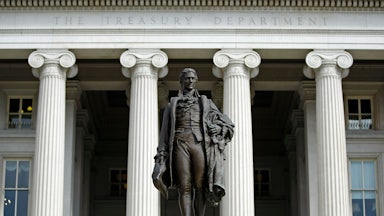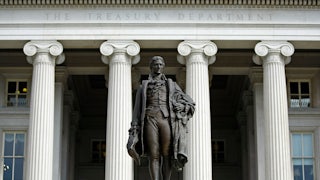During the two years they spent holding power in Washington, Democrats failed to disarm the debt ceiling time bomb that Republicans have repeatedly wielded over the past decade. Now they are wrestling with the potential consequences of the latest and greatest standoff over raising it. President Joe Biden and Speaker Kevin McCarthy are reportedly making little progress in negotiations over the trillions in unpopular spending cuts and new restrictions that the House GOP wants to enact in exchange for not blowing up the economy.
One solution would be for the Biden administration to recognize that the debt ceiling is unconstitutional. The Fourteenth Amendment declared in 1868 that the “validity of the public debt authorized by law ... shall not be questioned.” A logical reading of that language is that Congress cannot authorize spending that exceeds the nation’s tax revenues and then later forbid the Treasury to pay off that debt. But Biden aides are reportedly downplaying the use of this option to progressive lawmakers.
A recent lawsuit could nonetheless force their hand. The National Association of Government Employees, or NAGE, filed a federal lawsuit against the Biden administration earlier this month to block it from enforcing the debt ceiling. The union argued in a court filing last week that the debt ceiling violates the public debt clause and that abiding by it is already injuring NAGE’s members. A hearing on a preliminary injunction is set for next Wednesday. While its chances of success are uncertain, the lawsuit itself underscores the constitutional netherworld in which the nation’s leaders now find themselves.
Most debates over the debt ceiling’s constitutionality imagine that it will not become a courtroom matter until the bomb actually goes off. When that happens, the Biden administration will essentially have two choices. Treasury Secretary Janet Yellen can stop paying off existing debts and thereby default on the national debt for the first time in American history. Alternatively, she can “prioritize” making those debt payments over things like paying civil servants and mailing out checks to veteran pensioners. That would bring the United States into a state of technical default while theoretically mitigating some of the damage.
If Yellen instead chose to continue issuing new bonds to cover existing debt, that would violate the debt ceiling and likely set up a showdown at the Supreme Court. Most observers imagine in this hypothetical scenario that Biden or Yellen or a lawyer working for them would just say “Fourteenth Amendment!” while issuing the bonds; conservative legal scholars have argued that ignoring the debt ceiling on those grounds would itself be unconstitutional. “The idea that the Fourteenth Amendment gives the president unilateral power to borrow is dangerous nonsense,” Michael McConnell, a former federal judge, recently argued in a New York Times op-ed.
NAGE’s lawsuit spins some of these assumptions on their head. Most discussions of the debt ceiling depict it as a burden imposed upon the executive branch by Congress. The union argued that the debt ceiling actually amounts to a line-item veto for the president to wield at his own discretion. What appears to be a restriction based on the political dynamics of the situation is actually, according to the filing, an unconstitutional transfer of congressional power.
“Already near the debt limit, the last Congress adopted in the current fiscal year a budget that would require adding $1.5 trillion in debt without identifying or indicating any priority of payments once the limit on indebtedness was reached,” the lawsuit claimed. “Congress then failed to raise the debt ceiling or increase taxes and effectively offloaded the dirty work of repealing parts of the spending that Congress itself had just approved.”
The Supreme Court previously struck down a line-item veto in the 1998 case Clinton v. New York. Writing for the court, Justice John Paul Stevens noted that the Constitution had carefully and deliberately laid out the process by which bills become law. Deviations from that “finely wrought” structure are unconstitutional, especially when they result in “truncated versions” of the laws that were actually passed by Congress.
It would be one thing if Congress had laid out the order in which federal spending must be “prioritized” after the debt ceiling is met, the union noted. But it argued that Congress effectively delegated that power to decide which federal spending must be cut or canceled to the executive branch. By crafting a debt ceiling, Congress ceded a core legislative power to another branch of government and compromised its authority over federal spending.
Some legal scholars have already pointed out that the debt ceiling’s existence amounts to a constitutional no-win scenario for a president. Law professors Neil Buchanan and Michael C. Dorf recently noted that Congress had placed the executive branch in a “trilemma,” in which he must violate the Constitution in some way. “Once we hit the debt ceiling, Biden will bump into a constitutional obstacle no matter what he does,” they wrote in a Los Angeles Times op-ed. “Failing to spend appropriated funds, raising taxes, or borrowing money to pay the bills would all infringe on Congress’ constitutional powers.”
NAGE’s lawsuit also emphasized this quandary for the president. “The Debt Limit Statute has placed the President in an impossible position, without legislative permission or constitutional authority as to how to proceed,” the union said in its original complaint. “Under Article II of the Constitution, the President is obligated to execute all the laws, without exception, and may not be placed by Congress in a position where the President has to determine what laws are of continuing force and require payment, once the limit on total indebtedness is reached.”
What makes the union’s lawsuit noteworthy is also how it avoids some of the procedural questions that might bedevil other debt ceiling lawsuits. The U.S. technically already hit the debt ceiling on January 19, as Yellen informed Congress at the time. The Treasury has avoided default thus far by relying on what it describes as “extraordinary measures,” or certain creative accounting maneuvers. In this case, Yellen told lawmakers that she would suspend the Treasury’s investment and reinvestment in various civil servant retirement funds that were authorized by law, to give the country some breathing room.
In the filing, the union argued that this amounted to a legal injury for its members. “The debt issuance suspension period continues in effect and continues to diminish the value of the assets of the benefit plans of the CSDRF and Thrift Savings Plans in which [NAGE’s] members are participants,” it claimed. “While [Yellen] is required by 5 U.S.C. 8348 to make good on these losses when the debt issuance suspension period ends, there is presently no end in sight or increase in the debt ceiling, and the retirement plans continue to lose value.”
Maryland Representative Jamie Raskin told The Washington Post in a recent interview that, in his view, the Supreme Court is usually “fastidious” about whether a party has legal standing in a particular lawsuit, which would insulate ignoring the debt ceiling from legal challenges. NAGE argued that it had overcome the standing hurdle, albeit from the opposite direction. “Aside from this actual injury, [NAGE’s] members face certain and imminent harm when the United States runs out of cash to pay its bills,” the union also noted. “Although individual members may or may not be furloughed, and there will be different degrees of individual injury from layoffs, all of [NAGE’s] members face an imminent and certain injury from delay in their paychecks, whether for days, weeks, or months.”
Naturally, this is not how things are supposed to work. When Congress added the public debt clause to the Fourteenth Amendment during the Reconstruction era, its drafters’ immediate concern was various Civil War debts. But they also made clear that they had much broader aspirations in mind. “I have no doubt that every man who has property in the public funds will feel safer when he sees that the national debt is withdrawn from the power of a Congress to repudiate it and placed under the guardianship of the Constitution than he would feel if it were left at loose ends and subject to the varying majorities which may arise in Congress,” Massachusetts Senator Benjamin Wade told his fellow lawmakers during the drafting debates.
Will the Supreme Court agree? It’s impossible to say. Predictions about how the court would rule on particular cases are difficult even when they traverse familiar areas of constitutional law. The Supreme Court has heard vanishingly few cases on the public debt clause’s meaning since its enactment, however, and none of the court’s current members have ever been part of one. If the dispute reaches the justices, it might be one of the highest-stakes cases they ever hear. Nothing less than the integrity of the national debt and the stability of the American financial system would be on the line.










